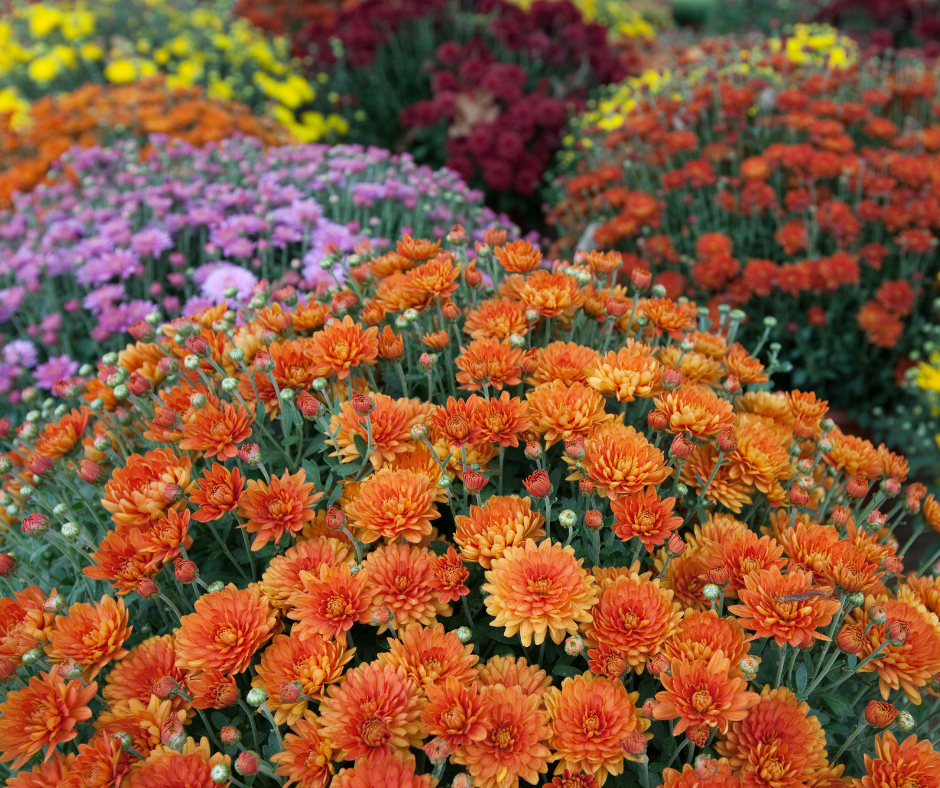No doubt about it! Mums are the divas of the autumn garden. Mums can quickly and easily add beautiful fall colors to your home. Because of their tight, mounding habit and stunning bloom colors, garden mums are perfect for mass plantings.
Although technically considered perennials, the garden mums that brighten up our landscapes in the fall are commonly treated as annuals. Because of the way they are bred, the likelihood of them surviving the winter and blooming within your desired time frame, is pretty slim.
Let us explain a bit further…
The best time to plant a mum in the garden is in the spring. Unfortunately, mums are hard to find in the spring although not impossible. We had some available in the retail store this spring but gardeners aren’t really interested in mums until they begin to flower. By then it’s too late.
Planting in spring allows the plant to establish a root system before it flowers. There is not always time for the mum to establish a root system when planted in the fall because it is still putting all of its energy into flowering and then when done flowering, it goes dormant. If planted too late, mums won’t have enough time to root and the roots may heave up out the ground.
Garden mums are grown in a greenhouse and are bred for maximum color and shape at a specific time in the fall. They are bred for flower size, flower color and plant shape so they look great in your garden for the fall. Their energy is more focused on blooms and less on root development.
Garden mums that do survive the winter and manage to come back in the spring could be spindly and unshaped due to the fact that they need to be pinched back on a regular schedule to even begin to look like the mum you purchased at the greenhouse.
But all is not lost and many have been successful in their endeavor. Here are some tips to help you beat the odds although there are no guarantees:
The first method is to overwinter the plant in its pot in a sheltered area, then plant it in the spring.
When your pot of mums doesn’t look good anymore and the foliage is dried, trim back the dead tops. Water the pot and place it in an unheated garage. Keep the soil barely moist; it can’t be dry.
Plant it in the spring; by April you should see new green growth sprouting. It will have all summer to root into the ground and you have a better chance of having the plant survive the next winter.
Planting in the fall: Your best chance for fall planting success is to plant as early as possible and pick the mums that are tightly budded. Keep your mum well-watered and spread a thick layer of mulch to help protect the roots. Plants can heave out of the ground when we have a lot of thawing and freezing during the winter months. Check them early in the spring. If the roots are heaving out of the ground, stamp the roots down with your foot.
Unfortunately, even if you do all this, there is no guarantee that your mums will act like a perennial and come back next year so it is often best to consider fall mums a beautiful annual to enjoy in the fall.
Help your mums thrive by providing them with full sun, keeping them consistently moist, and deadheading them (removing spent flowers as they finish blooming). Use mums as annuals for temporary color in your garden or on your porch, and compost them when they’re finished blooming.
Note: Mums are somewhat frost tolerant, but not totally frost tolerant. A good frost can damage opened flowers, but unopened buds should be ok. Best to cover with a sheet or blanket if you hear that there is a chance of frost.



